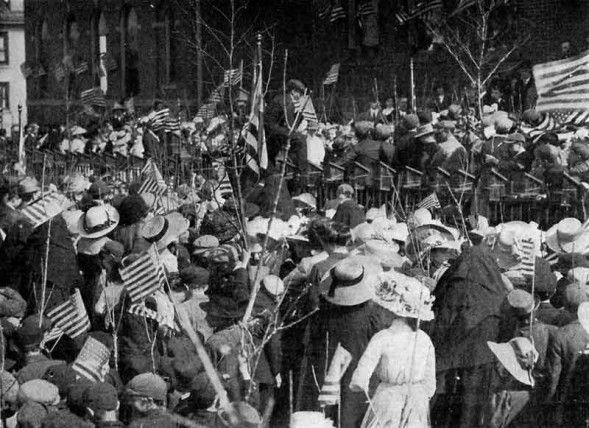Bird Day
Contents
Click Here for more on Bird Day 1894
These are images of "Bird Day" at the original Quentin Roosevelt Elementary School that was located on The Boulevard.
Bird Day and Arbor Day in Carrick
Almost no one has ever heard of “Bird Day.” Celebrated with Arbor Day, the holidays were popular in Carrick thanks to conservationist and Carrick resident John M. Phillips. Mr. Phillips lived in a huge home named Impton where St. Pius X Church is today. Around 1910 both holidays were observed statewide as a way for people, especially school children, to understand conservation with particular attention to the natural world and birds. Harriet Duff Phillips also notes the day in her autobiography.
On Bird and Arbor Days in Carrick school children were instructed and urged to make bird houses with contests sponsored by Mr. Phillips for the best. Hundreds of wren bird houses were constructed from wood, tin cans and garden gourds. School children gathered the gourds in the fall and hung in basements until February to dry. Then a hole the size of a quarter was cut into them, insides tediously scraped out and then shellacked.
Along with the bird houses thousands of Russian Mulberry and Cherry trees were given away by Mr. Phillips. He would teach boys and girls how to plant and prune them, exacting a promise that when the tree began to bear fruit half would go to the birds with the other half for themselves. Now you know why there isn’t a yard in our community without either a mulberry or cherry tree.
KEVIN C. ARMITAGE
ABSTRACT
Popular education was one of the most important elements of Progressive Era conservation. But what kind of education produced conservationists? Bird Day was typical of efforts in popular education in that it attempted to inculcate both moral passion and scientific objectivity in children and the wider public. Bird Day highlights the uneasy relationship between progressive conservationists and objective, quantifiable science, particularly the struggle by conservation activists to embrace the rational qualities of the scientific endeavor without sacrificing the emotional fervor that motivated popular interest in conservation.
There are perhaps few ways in which more practical good can be accomplished than by establishing in our schools a day devoted to the birds. (Forest and Stream July 18, 1896)
IN HIS 1913 CONSERVATION jeremiad Our Vanishing Wildlife, William Temple Hornaday, director of the New York Zoological Park, proposed a massive campaign of public education to combat the extermination of American fauna. With the righteousness of the true believing convert, Hornaday thundered that all our school children should be taught, in the imperative mood:
A. That it is wrong to disturb breeding birds, or rob birds' nests;
B. That it is wrong to destroy any harmless living creature not properly classed as game, except it be to preserve it in a museum;
C. That it is no longer right for civilized man to look upon wild game as necessary food; because there is plenty of other food, and the remnant of game can not withstand slaughter on that basis;
D. That the time has come when it is the duty of every good citizen to take an active, aggressive part in preventing the destruction of wild life, and in promoting its preservation;
E. That every boy and girl over twelve years of age can do something in this cause, and finally,
F. That protection and encouragement will bring back the almost vanished birds.
"Teachers," concluded Hornaday "Do not say to your pupils—'It is right and nice to protect birds,' but say:—'It is your Duty to protect all harmless wild things, and you must do it!'"
Hornaday endorsed one "splendid" example of existing pedagogy that emphasized moral duty toward wildlife: Bird Day.
Originated in 1894 by Professor Charles C. Babcock, superintendent of schools in Oil City, Pennsylvania, and modeled after Arbor Day, Bird Day immersed children in bird study and protection.3 Students researched and wrote about birds, performed plays and recited poems that underscored the aesthetic quality of avian life, and engaged in practical conservation by building bird boxes and planting trees. The moral outlook sought by Hornaday was a significant component of Bird Day programs. Children recited a litany of literary works that demanded kindness toward birds, and speakers beseeched them not to shoot birds, collect eggs, or wear birds on their hats, and to control their cats. In short, Bird Day was a teach-in for the conservation of birds. It is the forerunner of Earth Day and other contemporary celebrations intended to broaden environmental awareness, such as International Migratory Bird Day.
There are about 11646 more words in this article.

